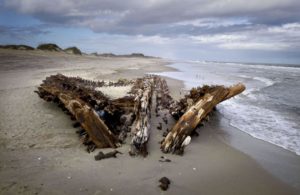A flight over beautiful Hatteras Island is a visual treat on any occasion, but when you can combine it with a history lesson, why not? My friends were recently guests of OBX Air Tour Adventures and loved flying over the few remaining visible shipwrecks along our Island’s coast. OBX Air Tour Adventures flies three pretty interesting aircraft: an air conditioned helicopter, an open cockpit biplane and an authentic WWII T-6 Texan, a single-engine advanced trainer aircraft originally used to train pilots in the United States Army Air Forces (USAAF), the United States Navy, the Royal Air Force and other air forces of the British Commonwealth. I don’t know which aircraft our friends enjoyed, but if it was the WWII T-6 Texan, it fit right in with the view off Sound Side Rodanthe of the Pappy’s Lane Shipwreck, a WWII assault vessel currently being investigated by a coalition of educational institutions and state agencies. The mystery surrounding the Pappy’s Lane Shipwreck was described in our last blog.
not? My friends were recently guests of OBX Air Tour Adventures and loved flying over the few remaining visible shipwrecks along our Island’s coast. OBX Air Tour Adventures flies three pretty interesting aircraft: an air conditioned helicopter, an open cockpit biplane and an authentic WWII T-6 Texan, a single-engine advanced trainer aircraft originally used to train pilots in the United States Army Air Forces (USAAF), the United States Navy, the Royal Air Force and other air forces of the British Commonwealth. I don’t know which aircraft our friends enjoyed, but if it was the WWII T-6 Texan, it fit right in with the view off Sound Side Rodanthe of the Pappy’s Lane Shipwreck, a WWII assault vessel currently being investigated by a coalition of educational institutions and state agencies. The mystery surrounding the Pappy’s Lane Shipwreck was described in our last blog.
The lovely Outer Banks day, calm clear water and our eager passengers made for a memorable experience, with spectacular views of the shipwrecks’ remnants. Flying from north to south they viewed the Laura Barnes and the Lois Joyce, both situated along Bodie Island’s ocean side. These two shipwrecks span a considerable period of time. The Laura Barnes, a four-masted schooner constructed in Camden, Maine, was driven ashore on June 1, 1921 during a nor’easter. Luckily the entire crew was rescued by Coast Guardsmen and the ship’s salvage was sold at auction, providing materials for numerous construction projects. The remains were relocated to Coquina Beach about a mile south of their original site to facilitate public viewing. The Lois Joyce, a 100-foot commercial trawler, was lost in 1981 when it was caught in a December storm while entering Oregon Inlet. Often covered by sand and tide, the Lois Joyce is located off the beach on the “North” cut at the mouth of the inlet. Again, the crew was rescued but the $1,000,000 vessel was lost.
The most romantic of the day’s visible shipwrecks was the Oriental, a Union transport grounded in 1862 on a sandbar near Bodie Island. A steamer built in 1861 for the sugar trade between the US and Cuba, the Oriental was named for a town in eastern Cuba but never saw its namesake. Drafted for use as a troop carrier by the Union Secretary of the Navy to enlarge the fleet, the Oriental made one trip from New York to Key West before its ill-fated voyage for Port Royal, South Carolina, landed it off the Outer Banks. The ship’s captain, Lou Ostendorff, claimed his compass had been incorrectly “swung” or checked for accuracy which in the storm brought the ship too close to the coast. Again all aboard were saved but the steel ship was lost. Today, the ship’s boiler and smokestack can be viewed off Pea Island Refuge opposite the Self-Guided Nature Trail. A curious aspect of the Oriental’s history was that its name was chosen by a little village at the mouth of the Neuse River on the Pamlico Sound. Today the town of Oriental is one of North Carolina’s premier sailing communities.
Lastly, the G.A. Kohler, a four-masted schooner constructed in 1919, was driven ashore in a hurricane in 1933. Crews from the Life Saving Stations Gulf Shoal and Chicamacomico, led by Coast Guard Captain John Allen Midgett, saved the crew using a Lyle gun and a Breeches bouy similar to those now on view at the historic Chicamacomico Life Saving Station museum in north Rodanthe. The vessel remained stranded on the beach for ten years before it was burned to obtain her iron fittings for the WWII war effort. The G.A. Kohler is located four miles south of Salvo at Ramp #27.
So a view of our happy island from the skies above provides scenic beauty and a short history lesson for those who live on and visit Hatteras Island.
